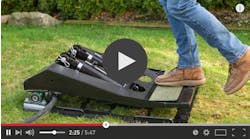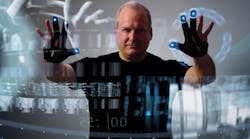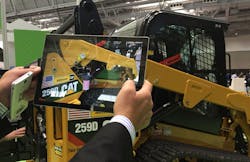Equipment manufacturers unveil new concepts that show how the IoT is converging with augmented reality and virtual reality, bringing sci-fi-like technology to industrial applications.
Given its strong foundation in 3D CAD modeling software, it should come as no surprise that PTC is betting its future on ways to help customers create and monetize rich, interactive user experiences that leverage those 3D assets. And its mashing those assets up with IoT, virtual reality, and augmented reality technologies.
"Most people think of the IoT as a way to connect, monitor, optimize, and automate remote products—these are powerful capabilities," said Jim Heppelmann, President and CEO of PTC. He presented the keynote at Liveworx, PTC's business IoT event, in Boston.
"But we at PTC think that the notion of digital and physical convergence needs to incorporate the way in which humans experience products, that's why we've spent so much time investing in virtual reality and augmented reality," he emphasized. "IoT + AR/VR, now that's a really big idea. "
Virtual reality (VR) is a digital representation of an environment that allows for user interaction, through a simulation of the user's physical presence. Augmented reality (AR) lets users to visualize a virtual product in the real world by overlaying (augmenting) a real-world environment with CAD models, graphics, sound, data, and other sensory input. Mixed reality, on the other hand, is a convergence of the real and virtual environment, where the two can co-exist.
PTC got a jumpstart in the space through the acquisition of the augmented reality company, Vuforia. The company recently announced a pilot program for Vuforia Studio Enterprise. Integrated with PTC's Thingworx IoT Platform, it's designed for users to create AR experiences from 3D data and virtual dashboards for connected products.
Three concepts involving industrial equipment were showcased at the event, demonstrating how IoT plus mixed reality can add value and positively impact the user experience when it comes to asset management, maintenance, sales and marketing, and training.
Caterpillar teams are bringing the physical world and digital world together, with the help of libraries of thousands of CAD models, virtual components, and systems across its entire product line.
Through virtual reality, Cat is optimizing the experience for operators and service technicians and asset management. At startup, the user sees a virtual representation of the machine based on sensor data, which displays voltages, battery utilization, and other operating characteristics. A red light indicates a fault condition.
The experience is further enhanced through augmented reality, whereby the user view on a mobile device a digital representation of the product overlaid on the actual product in the real world, as shown in the image above. For example, should the fault indicate that a battery needs to be changed, a technician can overlay a graphic showing an animated view of how the housing containing the battery is to be disassembled—down to the tiniest screw, if desired.
Cat also sees the potential for sales and marketing. "Physical inventory can be expensive, but with augmented reality a customer can see a life-size virtual representation and when coupled with animations can even open the doors and look inside," said Teri Lewis. "That's completely impossible with a brochure or photo."
A video released last year from Caterpillar demonstrates how several of these functions work:












